The results are in and show that 92.5% of the organizations represented by our response pool conduct performance appraisals! Here are a few more highlights of the survey:
 |
- Among participants, the top factor for evaluating both nonexempt and exempt employees is job knowledge.
- 4.5% of respondents believe performance evaluations are not a good idea and would like to see them abolished altogether.
- Performance evaluations are conducted annually for 4.8% of participants, while 13.5% conduct them every 6 months.
- Among organizations polled, 51.6% do not involve employees themselves when setting individual performance pay factors.
- Evaluations are tied to most salary increases for 42.5% of participants—but the two are completely separate for 20.8%
Thanks to all 1,198 individuals who participated! Here are the detailed results.
Who Participated?
Organizations with up to 250 employees account for 56.9% of our survey participants, and 23.4% have 251 to 1,000 employees. Another 16% employ 1,001 to 10,000 individuals, and 3.7% of participants work in organizations with more than 10,000 employees.
Privately owned organizations are represented by 53% of survey participants, and nonprofits account for 19.3%. Public corporations make up 13.6%, and governments are represented by 14.1%.
Industries include manufacturing (17.3%); health care and social assistance (15.2%); other services (except public administration) (11%); finance and insurance (8.9%); and professional, technical, and scientific services (8.4%). Educational services represent 8.2% of our survey participants, and public administration accounts for 4.8%.
Our survey participants are 15.6% staff level, 42.8% manager level, 26.3% director level, and 15.2% are VP level or higher.
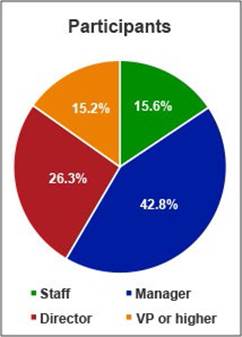
Performance Appraisals
Down from last year’s rate of 75.2%, only 65.3% rate their organization as average or above regarding the way it conducts performance appraisals, with excellent as the rating for 2.3% (2.1% in 2014) and above average selected by 22.8% (21.9% last year). The remaining 40.2% (51.2% in 2014) rated their organization as average. At the other end of the spectrum, 34.8% (24.8% last year) rate their organization as needs improvement or terrible in the way that performance evaluations are conducted.
Overall performance is measured by 79.8% of survey participants and specific attributes are measured by 45.2%. Completion of specific goals is a measurement criterion for 50.7%, and our favorite catchall “other” includes:
- Competencies
- Leadership behavior
- Core values and behaviors
- Developmental needs
- Industry knowledge
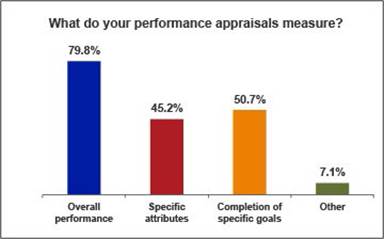
When asked what they do instead of standard performance appraisals, 73 participants (6% of survey participants) responded. Their alternatives to formal reviews include:
- Ad hoc feedback to employees
- Coaching discussions on a semiregular basis
- Management by objective or goal setting
- Corrective counseling
- Annual RIF
- COLA or longevity increases
- Everyone watches everyone else
- Notes to file
- Supervisor observation
- Personality tests
- Attendance awards
- Recognition programs
It’s the third HR Playbook from BLR®! Read the new guide, The Total Rewards Framework: Build Loyalty, Engagement, and Retention, and find out how to give employees what they most value.
Nonexempt Employee Performance Factors
The top five factors used when evaluating nonexempt performance include job knowledge (76.6%), quality of work (74.6%), attitude/cooperation (68.8%), communication skills (67.7%), and attendance/punctuality (65.2%).
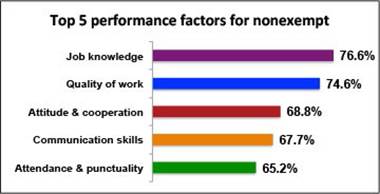
The five least used factors in nonexempt performance appraisals are leadership (27.9%), creativity (23.6%), staff development (20%), staff utilization (15.5%), and financial management (13.7%).
Flagged by 7.6% of survey participants, the “other” basket included performance factors such as:
- Knowledge sharing
- Grooming
- Attention to detail
- Teamwork
- Personal accountability
- Integrity
Exempt employee performance factors
The top 5 factors used when evaluating exempt performance are job knowledge (75.2%), communication skills (73.9%), quality of work (72.8%), achievement of preset goals (72.6%), and attitude/cooperation (66.9%).

The five least used factors in exempt performance appraisals are safety (42.8%), resourcefulness (40.4%), financial management (39.9%), staff utilization (38.7%), and creativity (35.7%).
The “other” basket (7.6%) for exempt employee performance factors includes networking, client retention, accountability, ethical and legal standards, teamwork, business development, integrity, collaboration, accountability, and alignment with company goals.
Evaluation Process
Not surprisingly, supervisors evaluating employees is the norm for 98% of survey participants. Employee self-evaluation is part of the process for 58.8%, and peer evaluation is a best practice for 9.7%. Subordinates evaluating supervisors is an option for 7.5% of survey participants, and 5.2% have a mechanism in place for customers to evaluate their employees.
When asked which employee groups do not receive evaluations, 40.9% indicated that temporary employees’ performance is not formally reviewed. Senior management/executives are not reviewed by 24.8% (19.6% in 2014 and 23% in 2013), and part-time employees do not receive performance reviews at 13.7% of survey participants’ organizations.
Performance evaluations accomplish their intended goal most of the time for 47.3%. They are great in theory but nearly impossible to implement for 28.3%, and 4.5% believe they are not a good idea and would like to abolish them altogether.
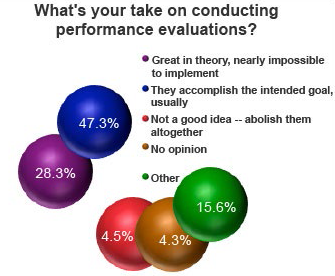
Our old friend “other” was selected by 15.6% of participants when it came to their take on conducting performance evaluations. Comments included:
- “When done correctly, can provide valuable information to employee regarding performance.”
- “Appraisal ratings are biased and the department heads do not rate based on their employees’ performance.”
- “If done correctly they accomplish the intended goal.”
- “Necessary evil, getting managers to give it the time value it needs is the challenge.”
- “They are a very useful tool but require support from the top down.”
- “The success of the process is in direct correlation to the efforts put into by the stakeholders (employee, supervisor, HR, and Mgmt).”
- “Conversations should take place on a regular basis and evaluations are needed if you pay for performance.”
- “Great in theory but inconsistent in application from supervisor to supervisor.”
- “They need to be a continuous process of coaching and developing.”
- “Very important, requires nudging to get done.”
- “Performance feedback is valuable to employees, but supervisors don’t want to spend much time on it. They think of it as just more paper they have to fill out.”
- “Some employees are better served by them than others.”
Rewards are about more than just pay and benefits! Find out everything you need with the new HR Playbook, The Total Rewards Framework: Build Loyalty, Engagement, and Retention. Find out more or order here!
Frequency/Timing
Performance appraisals are conducted annually for 47.8%. They are conducted after the first 90 days and then annually thereafter for 23.4%. Reviews are every 6 months for 13.5% of survey participants, and 2.8% have no firm schedule. The “other” basket for this question reveals quite a few options, including:
- Every 2 years
- Annually with a midyear check-in
- Quarterly
- After the first 90 days, after 6 months, then annually
- Every 6 months
- When job performance deteriorates
- Depends on the employee
- Every 13 weeks and annually
- Annually with quarterly assessment of goals
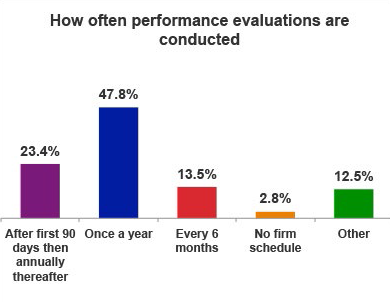
New employees receive their first performance review after 6 weeks on the job for 8% of survey participants and after 3 months for 46.3%. Newbies get their first review after 6 months for 17.1% and after 9 months for 0.8%, while 14.6% receive their first indicator of success or failure after a full year of employment.
What we do. A common review date is utilized by 55% of participants, and a variation of common review dates (e.g., common dates staggered by groups) is used by 6.4%. Appraisals are spread out over the year for 21.2%, and a combination of common date and scattered throughout the year is used by 9.8% of survey participants.
What we’d rather do. Conducting all reviews at the same time is preferred by 42.8%, and 30.9% prefer that they be spread throughout the year. A combination is preferred by 18.4%, and 7.9% had no opinion one way or the other.

The frequency with which individual pay-for-performance plans are aligned with organizational objectives and strategies is annually for 60.1% and biannually for 1.8%. Alignment is intermittent with no set schedule for 9.1% and never (as far as they know) for 23.6% of survey participants.
We will provide more results of our Performance Management Survey in tomorrow’s Advisor, plus an introduction to BLR’s new HR Playbook: The Total Rewards Framework: Build Loyalty, Engagement, and Retention.
